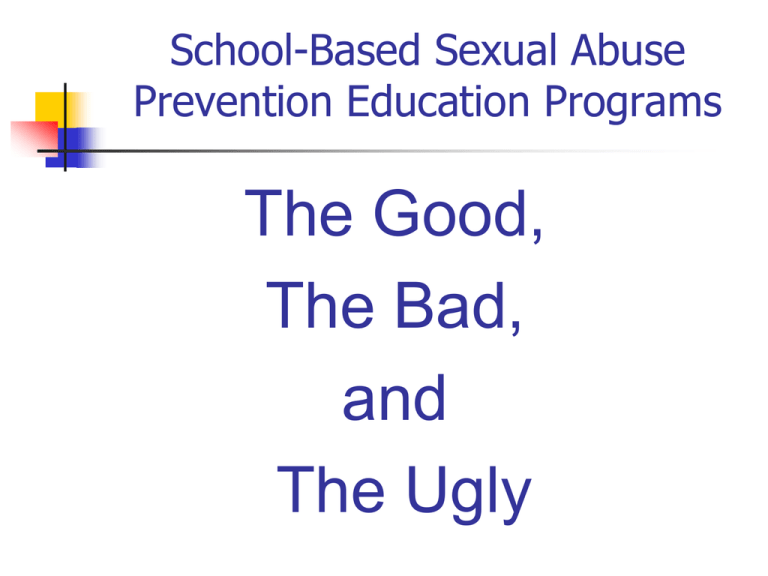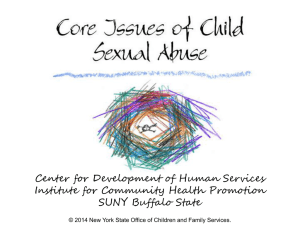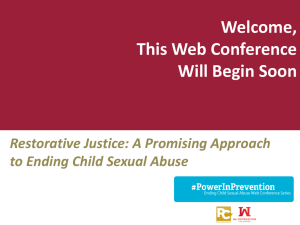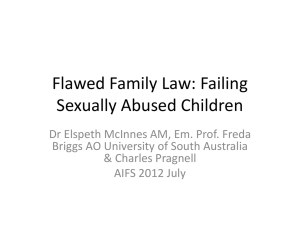School-Based Prevention Education ppt, Ellen Teller, 4-2-2013
advertisement

School-Based Sexual Abuse Prevention Education Programs The Good, The Bad, and The Ugly Presented by Rhonda Kane, MA, LPC ESC ECSC Francis Howell School District Ellen Teller, M.Ed., LCSW Executive Director The Child Center, Inc. 636-332-0899 What is Child Sexual Abuse Prevention? Programs aimed at keeping abuse from occurring Programs aimed at empowering those who may be victimized Programs aimed at empowering those who are protective of children What's Happening with Child Sexual Abuse Prevention? Community Denial of the problem of sexual abuse Parents do not talk with children about sexual abuse prevention (Sexual Assault and Trauma Resource Center of Rhode Island) Only 61 % of elementary schools in the US offer some kind of child abuse prevention education (Donnelly) Children of all ages can successfully make use of prevention skills What Works in CSA Prevention Programs? School-based, child-focused Successful, comprehensive sexual abuse prevention programs need to teach certain skills and utilize specific teaching methods. (Finkelhor and DziubaLeatherman). Only 1/3 of all sexual abuse prevention programs appear to meet the criteria for a "comprehensive" approach (Plummer) Prevention Program “Don’ts” Stranger Danger Good Touch - Bad Touch Don’t focus on only certain “private parts” of the body Prevention Program Quality Revising existing programs to match current research on child sexual abuse Multi-session programs Annual evaluations to assess the implementation and effectiveness of programs Effecting Change Multiple sessions Training teachers Evaluation of programs Increase parent involvement Use a variety of approaches Stable funding source(s) Senate Bill 54 Effective August 28, 2011 Amy Hestir Student Protection Act Sections 160.2100 & 160.2110 of the Bill Creates the Task Force on the Prevention of Sexual Abuse of Children. This act shall be known and may be cited as "Erin's Law." Governor’s Task Force Must make recommendations for reducing child sexual abuse. Must submit a final report with its recommendations to the Governor, General Assembly, and State Board of Education by January 1, 2013. Section 162.069 By January 1, 2012, each school district must include in its teacher and employee training: a component that provides information on identifying signs of sexual abuse in children of potentially abusive relationships between children and adults Section 162.069 con’t. Have an emphasis on mandatory reporting Training must also include an emphasis on the obligation of mandated reporters to report suspected abuse by other mandatory reporters. Task Force 19 Recommendations: Community Based CSA Prevention (1 – 5) Professional Training/Technical Assistance Multi-disciplinary Team Excellence Mental Health Services and Treatment Awareness – public Funding Statutory Changes Community-Based CSA Prevention Recommendation #1 Needs to be expanded and comprehensive in nature Children basic/age-appropriate info Boundaries Inappropriate touches Language Suggestions for Children Bodies are private You have the right to decide about touches NO-GO-TELL-KEEP TELLING Tricks (Secrets, Threats, Bribes) Not your fault Community-Based CSA Prevention Recommendation #1 Parents Become protective Observe and monitor relationships their children have with adolescents and adults Suggestions for Parents Don’t force unwanted affection Listen to your gut instincts Know your child’s world Community-Based CSA Prevention Recommendation #1 Staff/volunteers in youth-serving organizations and schools Assumption that people who sexual abuse children may work for them Create an environment that is inhospitable for this Trained leaders Staff proper education to identify - report Community-Based CSA Prevention Recommendation #1 Community Community leaders/elected officials – begin the discussion about ending silence about CSA Advocate for policies and training Ultimately this creates cultural norms to form protective barriers – identify and respond to problematic behaviors Community-Based CSA Prevention Recommendation #2 All schools/youth-serving organizations should have specific CSA prevention policies. Establish boundaries Minimize opportunities for harm Staff education Community-Based CSA Prevention Recommendation #3 Existing programs should include programming targeted at preventing CSA Most programs discuss only child abuse, not CSA State and federally funded programs could be mandated to address CSA Community-Based CSA Prevention Recommendation #4 Expand home-visiting programs to include CSA prevention Current home-visitation program in Missouri does not include CSA Community-Based CSA Prevention Recommendation #5 Create and implement standardized training for all mandated reporters. Professionals Licensing and credentialing organization require specific CEU’s bi-annually Pre-service training MR training, Undergrad and graduate programs Majors/minors Mandated Reporter Training Dynamics of Child Sexual Abuse Types & Process of Disclosures Child Advocacy Centers Role as Mandated Reporters Signs and Symptoms Resistance Schools/School Districts Parents Addressing concerns Communities Education and awareness Community Support Community cooperatives – CAPE All Agency collaborations Community needs assessments Children’s Needs Panel Funding State Local Foundations Corporate Donors Next Steps? Questions? Comments? Concerns? References Finkelhor, David. (2009).0e Prevention of Childhood Sexual Abuse. Future of Children, 19(2). Wurtele, Sandy, School-Based Sexual Abuse Prevention Programs: A Review. Child Abuse & Neglect, 11(4), 483-95. Wurtele, Sandy, Off Limits Missouri Comprehensive Guidance Manual Missouri Department of Social Services, Children’s Division. (2010). Mandated Reporter Guidelines from Children’s Division.










